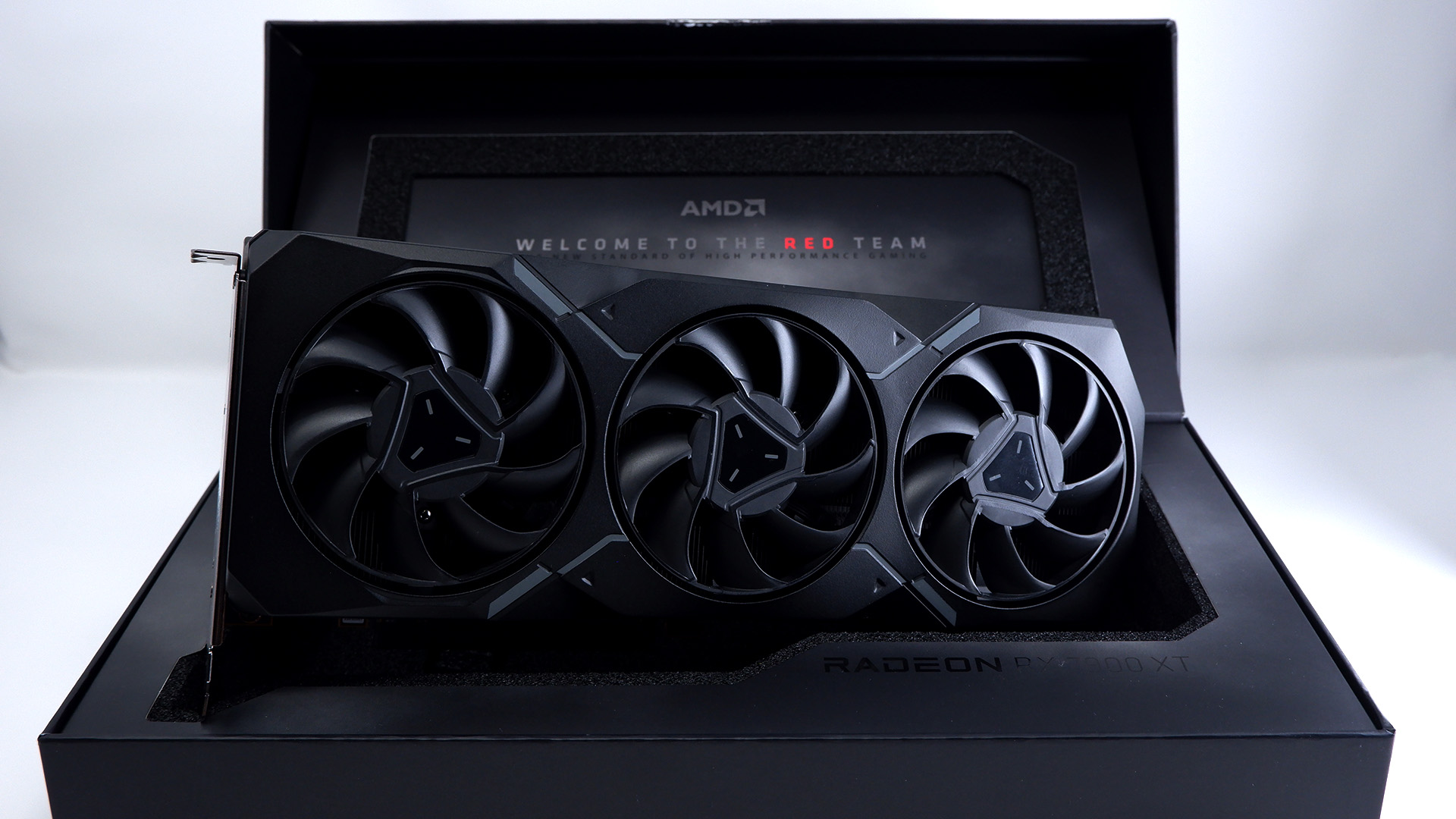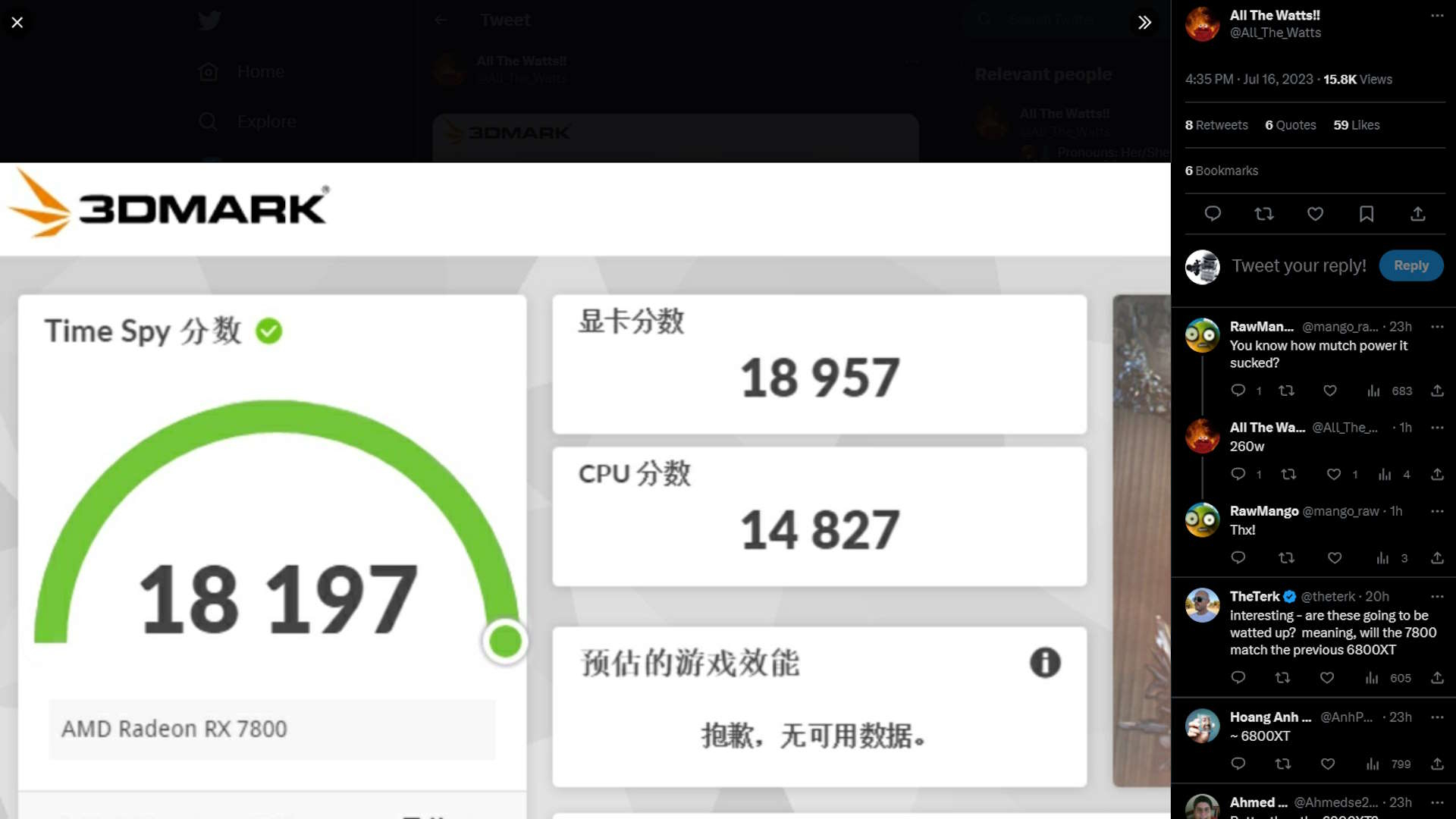Leaked 3DMark numbers suggest AMD's next graphics card should undercut the RTX 4070 and outperform it
New leaked performance figures for the RX 7800 suggest it will deliver higher rasterised performance compared with the RTX 4070.

AMD's next graphics cards should be landing in our laps sometime in September, according to new rumours, but just how excited you might be about that depends on how much stock you put into recently leaked 3DMark performance numbers.
Y'see, relatively reliable twitter leaker All The Watts (via Appuals) has posted a screenshot purporting to show the performance of the Radeon RX 7800 running 3DMark Time Spy. And it's slower than the Radeon RX 6800 XT, and offering only an 18% higher score than the average RX 6800 non-XT score.
While she states that it was running more efficiently—sucking down 260W—that does still make it more thirsty than the equivalent Nvidia GPU, the RTX 4070. And that's whether the 260W figure is taken as a peak power draw or an averaged figure for the RX 7800.
The RTX 4070, however, does deliver a lower 3DMark Time Spy score, but peaks at 230W with an average power draw below 200W.
We may not be massively happy with how Nvidia has filled out its new generation of Ada graphics cards, at least we're approaching a full stack of new GPUs. AMD's Radeon RX 7000-series, however, is still sporting just two cards in the RX 7900 XT and RX 7900 XTX.
That relative tardiness to fill out its stack isn't without precedent in AMD-land, but it's interesting to note that while the rumour mill is grinding away on leaked performance figures, we still don't 100% know the make-up of the GPU at the heart of the RX 7800 cards.

Previous rumours have suggested that, contrary to using the expected lower-spec chiplet GPU, Navi 32, the RX 7800 might ship using a cut-down version of the Navi 31 used in the previously released RX 7900-series cards. Given that a Radeon Pro W7800 exists in that styling lends some credence to such rumours.
Keep up to date with the most important stories and the best deals, as picked by the PC Gamer team.
A video posted over the weekend from the MILD YouTube channel, however, claims that Navi 31 card isn't likely to launch anytime soon, and the expected September launches will be Navi 32 GPUs with 60 Compute Units (CUs) and either 48 or 54CUs. If the RX 7800 card in the 3DMark Time Spy leak is indeed this 60CU part that gives it essentially the same core configuration as the RX 6800 that preceded it.
| Header Cell - Column 0 | Radeon RX 7800 | Radeon RX 6800 | GeForce RTX 4070 |
|---|---|---|---|
| 3DMark Time Spy GPU score | 18957 | 16123 (avg) | 17853 (avg) |
| VRAM | 16GB GDDR6 | 16GB GDDR6 | 12GB GDDR6X |
| Peak power draw | 260W | 378W | 232W |
| Price | ? | $579 | $599 |
A new generation card with just 18% higher 3DMark performance and effectively the same power draw doesn't necessarily feel like a spectacular result from the new RDNA 3 architecture. Though it is worth remembering this is AMD's first go at a nominal chiplet GPU design; the fact it's got it working with Windows at all is surely something.
In the end it's likely to all come down to pricing. As ever in the modern world of graphics cards.
Should AMD launch the RX 7800 at the same price as the RX 6800's $579 launch price it will undercut the competing RTX 4070 by at least $20 and potentially deliver higher rasterised gaming performance. Nvidia will counter that it's got DLSS and Frame Generation, and far better ray tracing capabilities in games that support it.
If AMD wants to come out swinging, however, it could drop the new card at the same $499 price point as the RTX 4060 Ti 16GB card and laugh all the way to the bank. That would require AMD to be manufacturing at volume, and this sort of aggressive pricing hasn't been part of recent AMD history. So, I'd still expect a status quo $550+ price tag to accompany the RX 7800 when it does launch.

Dave has been gaming since the days of Zaxxon and Lady Bug on the Colecovision, and code books for the Commodore Vic 20 (Death Race 2000!). He built his first gaming PC at the tender age of 16, and finally finished bug-fixing the Cyrix-based system around a year later. When he dropped it out of the window. He first started writing for Official PlayStation Magazine and Xbox World many decades ago, then moved onto PC Format full-time, then PC Gamer, TechRadar, and T3 among others. Now he's back, writing about the nightmarish graphics card market, CPUs with more cores than sense, gaming laptops hotter than the sun, and SSDs more capacious than a Cybertruck.

